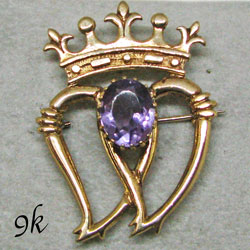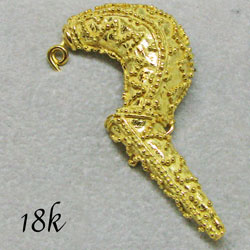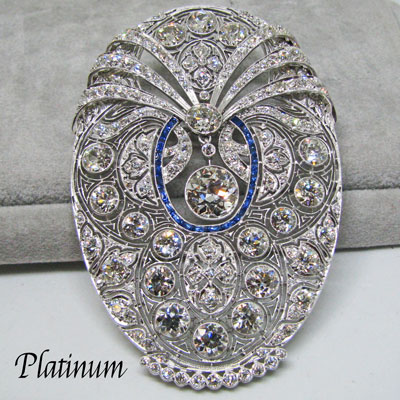Gold
| Karats | Parts | Percentage Gold | Foreign Stamping |
|---|---|---|---|
| 10K | 10/24 | 41.60% | 416 |
| 12K | 12/24 | 50% | 500 |
| 14K | 14/24 | 58.33% | 585 |
| 18K | 18/24 | 75% | 750 |
Karat gold in the US and abroad
The highest karat gold usually used in Western countries is 18k but gold as pure as 22—24k is popular in the Orient, especially in Thailand.The lowest karat gold used is 10k (9k in England).


Higher karat gold is more yellow in color than lower karat gold
| Gold Color | Alloying Metal(s) |
|---|---|
| Green | Silver, perhaps with traces of cadmium and zinc |
| Rose | Copper, which often causes rapid discoloration. |
| Yellow | Silver and copper (the more copper, the darker the yellow) |
| Blue | Iron |
| White | 10-20% nickel plus zinc, copper, tin, and perhaps platinum or manganese. |
Colored Gold
Gold and costume or fashion jewelry
Gold Filled
Heat and pressure is used to apply a layer of karat gold to a base of less costly metal, often copper, brass, or steel. The jewelry appears gold but since only a fraction of the metal is actually gold it is much less expensive. To be designated as gold filled at least 1/20th of the total weight of the metal must be karat gold. The stamping of a piece of jewelry that is 14k gold filled will read something like “1/20 14k G.F.” or “14k G.F.”
Rolled Gold Plate
The same process that is used for gold filled metal is also used for rolled gold plate but the layer of gold will be thinner, it is not required to be 1/20 karat gold. The stamping for this type of plating is “1/30 or 1/40 14k R.G.P.” or “14k R.G.P.”
Gold Electroplate
Electroplating, used for gold and silver, is the process of applying a layer of precious metal to a less expensive metal through the process of electrolysis. The base metal is immersed in a tank of water and chemicals with a piece of gold. An electric current is run through both metals which carries gold ions across to the base metal, bonding to the surface of the base metal. This is the cheapest plating method and usually, though not always, produces thinner layer of gold than gold filled or rolled gold plate. Plated jewelry is often not stamped at all but may be stamped “gold electroplate”, “G.E.” or “H.G.E.” (heavy gold electroplate).
Vermeil
Using the same process as electroplating, a layer of gold is applied to silver instead of a base metal. Since silver is also a precious metal, vermeil jewelry is usually considered fine jewelry, unlike jewelry that is gold plated over a base metal.
Regardless of the method used, gold plated jewelry has its drawbacks. Since the gold layer is very thin it will wear away over time to reveal the metal beneath, however the thicker the layer of gold the longer the beauty will last. Plated jewelry should not be polished, since the process of polishing removes scratches by removing a layer of metal. Polishing will most likely remove the thin layer of gold revealing the metal beneath.
Silver

Like gold, silver is available in various levels of purity.
| Type | Purity | Fineness Mark | Uses |
|---|---|---|---|
| Fine Silver | 99.99% or .9999 | 999 | Bullion investment products, it is generally considered too soft for industrial, commercial, or jewelry use. |
| Britannia Silver | 95.84% or .9584 | 958 (since 1999) was formerly the symbol of Britannia | Introduced in England in 1697 to replace sterling silver for items of “wrought plate” in an attempt to limit the clipping and melting of sterling silver coinage. After complaints from the trade because Britannia silver is softer than sterling silver, sterling was again authorized for use by silversmiths in 1720. |
| Sterling Silver | 92.5% or .925 or higher | 925 or higher | Jewelry |
| Coin Silver | 90% or .9000 | 900 | US Silver coins |
The European market handles alloys with 87.5%, 83%, and 80% silver and should be marked with its actual fineness.
Silver and costume or fashion jewelry
Silver Filled
As with gold filled, silver filled is a mechanical process where a layer of silver (92.5% fineness or higher) is pressed on to a lesser metal. The silver must make up 1/20th or more of the weight of the piece. Silver filled may also be called silver overlay.Silverplate
A fine silver film is deposited on a base metal by electrolysis in the same kind of electrically charged bath used to make gold electroplate. These pieces are said to be electroplated and cannot legally be called silver, sterling or bear a fineness mark signifying silver. Be aware, though, there are many pieces out in the market place that are illegally marked.Vermeil
This is a sterling silver piece that has been plated with gold.
Platinum
The Platinum Group
Platinum is the rarest and most expensive of the precious metals, not to mention the most durable. Platinum has been used in jewelry only relatively recently. This is because platinum has a melting point of 3190°F or 1755°C, much higher than gold or silver. The old-fashioned jeweler’s blowpipes were not adequate for working it unless they first combined it with arsenic, which was obviously dangerous. As a result, it wasn’t until the invention of the oxyhydrogen torch in the mid-1800s that made working with platinum practical.
Platinum occurs in association with other rare metallic elements known collectively as the platinum group metals. They include platinum, iridium, palladium, ruthenium, rhodium, and osmium. Platinum is the most abundant, but all, with the exception of osmium, are used in jewelry.
Jewelry platinum is typically an alloy of 90% platinum and 10% iridium as a hardener. An alloy of 95% platinum with 5% ruthenium hardener is as hard, while 95% platinum with 5% iridium is softer. Palladium alloyed with a small amount of ruthenium has been used largely in setting heads, with the advantage of being lighter and less expensive, but it does not hold the stones as firmly.
Rhodium is primarily as a plating metal to give white gold and platinum a bright, hard finish, and to slow tarnishing on sterling silver. It is also common practice to rhodium plate yellow gold heads in which diamonds are set.

Fineness Marks
Platinum jewelry is usually marked Platinum, Plat, or PT followed or preceded by numbers indicating the percentage of platinum.
Silver, White Gold, or Platinum
Silver is the least expensive and the whitest metal but tarnishes easily and is more difficult to work with the torch. White gold resists tarnishing better and for torchwork is easier to control but is more expensive, tends to yellow, and is harder to shape. Platinum is harder and responds well to mechanical tooling, holds stones securely, and resists tarnish well but it is the most expensive and heaviest metal, requires high torch temperatures, and is more difficult and expensive to work.
Platina 4
Platina 4 is a unique precious metal alloy that combines gold, silver, platinum, and palladium. Comprised primarily of silver it gives consumers an inexpensive alternative to gold jewelry. Jewelry marks for Platina 4 include P4 and P4SR.